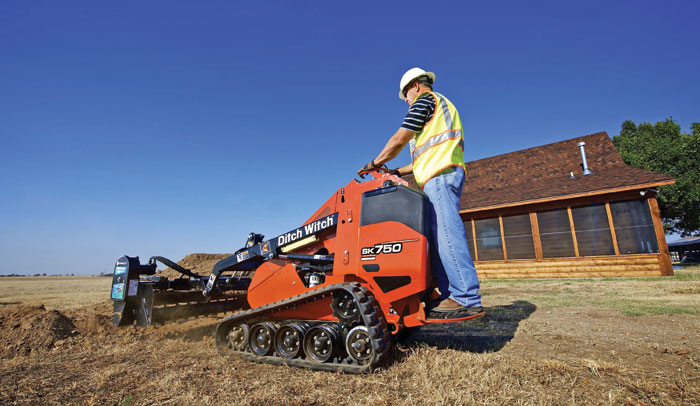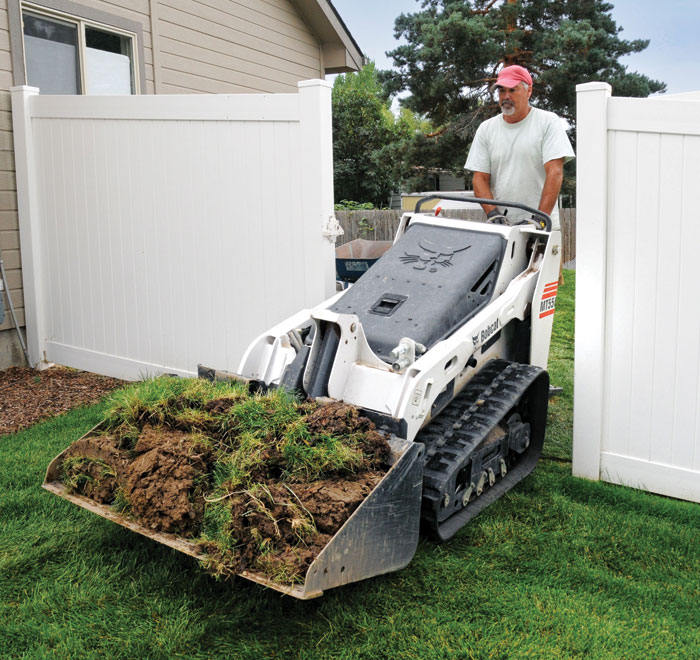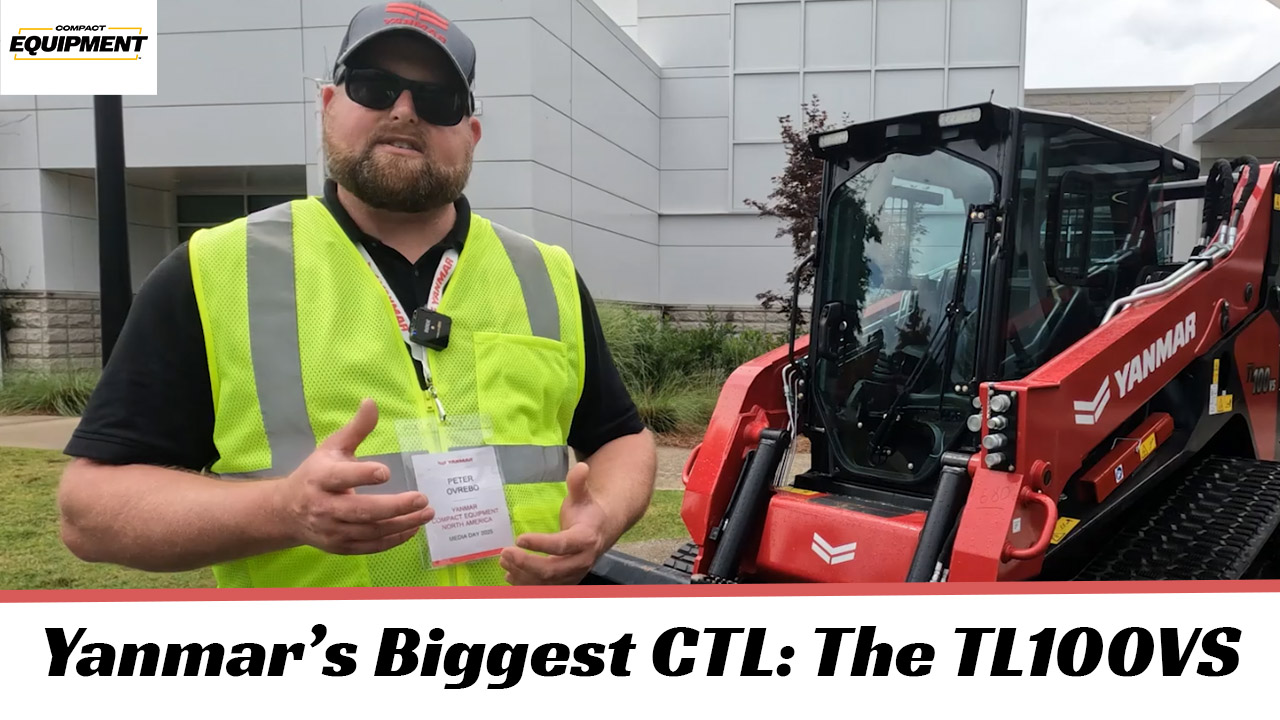Charge of the Light Brigade
Many machines can manipulate attachments — skid steers, track loaders, telehandlers, tractors, excavators — but few attachment-takers get smaller and more versatile than a compact tool carrier. Sometimes called mini track loaders, compact skid steers or compact utility loaders (depending on the brand), compact tool carriers are designed for precision work on cramped urban construction sites, sensitive landscape projects and specific trades (like fencing or demolition).
They auger for ornamental trees, carry buckets of gravel, trench for drainage, haul pallets of brick and cut down on extra hand labor. The ability to change and adapt in small environments is a compact tool carrier’s greatest strength. Off of the front of each unit, a universal attachment plate (plumbed with a hydraulic power system) can run any number of attachments — breakers, trenchers, tree spades, backhoes, brooms, graders, ground conditioners, augers, stump cutters, grapples and lots more. Many manufacturers can offer more than 50 different models of attachments (most are hydraulic implements, but some are not, like buckets and pallet forks).
Toro and Ramrod Equipment were some the first brands of machines in North America 30 years ago. Today, Bobcat, Ditch Witch, Vermeer and BOXER have all carved out their territories in the compact tool carrier market in the last 10 plus years.
“Compact tool carriers are popular with contractors working in landscaping and construction who rely on the machines to eliminate hand labor in confined or tight constrained work areas, as well as the rental industry,” says Mike Fitzgerald, Bobcat loader product specialist. “It used to be that you either had larger machines or a shovel, but nothing in between. The popularity of compact equipment, like compact tool carriers, has increased greatly and makes an operator’s job immensely efficient and eliminates a significant amount of manual labor.”
A high-tech crew can save money with such a clever, labor-saving device. It just takes a little investment. Compact tool carrier are not cheap, but they can replace hand labor with the ultimate mechanical employee. The average cost of a compact tool carrier with a four-piece attachment package and a trailer is less than $30,000. Add that to approximately $1,500 yearly for maintenance and fuel — not to mention depreciation — and it’s almost as if you are paying the salary of a full-time employee. Perhaps you need to install miles of fencing, ferry products and spoils to and from an urban garden or tackle indoor demolition and cleanup — a compact tool carrier can spearhead the variety of tasks involved in a diverse day of work (more than almost any skilled laborer).
Compact tool carrier are often categorized by operating capacity (between 200 to 1,200 lbs), but they can also be classified by what a contractor is looking for in a unit. The most obvious classifications include walk-behind and stand-on, type of engine (gas or diesel) and wheels and tracks. Like all machines, understanding your jobs will help determine your perfect piece of iron.
“With the variety of models now available on the market, the best way to determine which product is right for you is to demonstrate the equipment on the jobsite,” says Matt Collins, compact product manager with Ditch Witch. “This is an important step in the buying process as it allows time to evaluate different models and identify which model provides the best financial investment.”
When it comes to the power plant, 25-hp engines are the most common in compact tool carriers. Diesel is popular among construction and certain landscape contractors who want a long lasting engine with good fuel mileage. Gas is popular with the rental yards and landscape operations that use other gas equipment (and that are more comfortable with gas engine technology). Kohler, Kubota, Kawasaki, Honda and Perkins are popular engine OEMs in the compact tool carrier market.
Moving outward from the engine, every compact tool carrier manufacturer has engineered its own set of unique technologies: ride-on, stand-on and foldable stand-on platforms; hydraulic flow ratings from 6 to 22 gpm; retractable undercarriages; enhanced operator control patterns; choices in tracks or wheels; and more attachments than you can shake a stick at (stick shaking being the preferred measurement of choice at Compact Equipment).
Ditch Witch, BOXER and Vermeer offer stand-on compact utility loaders, but only stand-on units. They say the industry is turning toward stand-on platforms. The platform makes it easier on the operator by not having to walk through mud or jobsite debris. It will also allow them to be more productive, since they will not be walking all day long to and from the work area. Toro and Bobcat offer both walk-behind and stand-on alternatives. Walk-behinds are often great units when it comes to rental (where safety is a major concern) and for contractors who like the option of planting their feet firmly on the ground.
Bobcat and Toro also offer unique, switcheroo compact tool carriers; Toro’s TX platform has the ability to self store against the machine, allowing an operator to walk behind the machine or ride, and Bobcat offers its optional stand-on platform available for both the MT52 and MT55 mini track loaders.
“Bobcat has one of the only compact tool carriers in the industry that has the optional wheeled ride-on platform,” says Fitzgerald. “This provides additional convenience and comfort to the operator decreasing operator fatigue when the loader is traveling over long distances or is working over many hours. Along with convenience, the platform also provides a safe place for the operator to stand ensuring they are always in control of the machine.”
Besides the manufacturers that design and sell the unit, many third-party manufacturers also make compact tool carrier implements, including Danuser (www.danuser.com), McLaughlin (www.mightymole.com) and the Paladin brands of attachments, which includes Bradco, McMillen, The Major and Sweepster/FFC (www.paladinbrands.com).
Pick the right attachment, choose the right engine, determine wheels or tracks and decide on the right size model for your operations.
In this uncertain economy, it pays to find the right tools that can increase your staying power. Compact tool carriers offer new types of versatility and clout for many landscape and construction operations. If you’re unsure about a purchase, try renting one. Rental is one of the most popular markets.
“When evaluating markets for compact tool carriers, the rental market is a key segment for future growth and expansion,” says Collins. “If you are considering renting a CTC, my advice would be to have the rental store do a complete walk around of the machine. Get familiar with the operator’s manual and make sure you understand how to properly operate the unit. Don’t be afraid to ask questions and make sure that you understand the limitations of the machine. Rental rates vary by state and other variables, but here’s a quick range of prices customers could expect to see when renting a CTC — daily $120 to $180, weekly $350 to $650 and monthly $1,000 to $1,800.”
Keith Gribbins is managing editor of Compact Equipment, based in Brecksville, Ohio.






